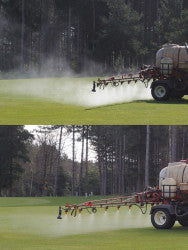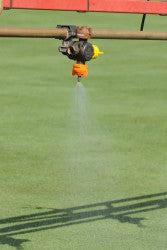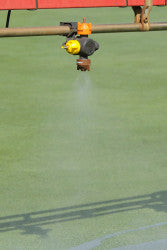Drift away ...
As the final point of delivery, the choice of nozzle ultimately dictates spray coverage on the leaf and, most importantly, spray retention on the intended target. Operators can use their choice of nozzle to tailor droplet size to the turf structure and the spray target.
 The choice really depends on the target for the spray. For foliar applications, where the intention is to hold as much of the spray on the leaf as possible, small droplets provide a greater leaf coverage for any given spray volume and are generally retained well on the leaf surface. When the droplet size is halved, the number of drops produced goes up by a factor of eight, and the coverage of the leaf may be up to four times greater.
The choice really depends on the target for the spray. For foliar applications, where the intention is to hold as much of the spray on the leaf as possible, small droplets provide a greater leaf coverage for any given spray volume and are generally retained well on the leaf surface. When the droplet size is halved, the number of drops produced goes up by a factor of eight, and the coverage of the leaf may be up to four times greater.
However, the problem for operators is that fine droplets are more difficult to control and more likely to result in drift - which is bad news for environmental loss and, if the product never reaches the intended target, reduces the efficacy of results.
The challenge for turf spray operators is made more difficult since dense turf is a very flat, uniform surface with little internal air movement, which makes it hard to get spray to hit the leaves. Fine droplets just hover above the surface in a boundary layer of air; if there is any wind they can drift off.
Spraying on a still summer evening, when there may also be upward thermal currents from the warm soil, can result in fine droplets being lifted up and carried off - which is another reason why spraying early in the morning is often preferred.
If you are spraying longer, more open turf - such as fairways and areas of rough around the golf course or some amenity situations - then the grass canopy can create its own vortex, which effectively sucks down the spray droplets and improves leaf coverage.
Turbulence generated by the sprayer itself is also generally bad news. If you double the forward speed, the turbulence is increased by a factor of four, which may make it harder for small droplets to break out of the air flow and land on the target. It is a factor to consider when moving to faster forward speeds.
 The logical solution would appear to be a move to larger flat fan nozzles, such as an 05 or 06 - which are commonly used in turf applications to achieve water volumes of 400 to 600 litres per hectare.
The logical solution would appear to be a move to larger flat fan nozzles, such as an 05 or 06 - which are commonly used in turf applications to achieve water volumes of 400 to 600 litres per hectare.
However, larger droplets from flat fan nozzles tend to overwet the leaf on impact and lead to high levels of run-off, which is counter-productive when trying to hold foliar applications on the leaf. The higher velocity of larger droplets can cause them to physically bounce off the target. Also, all flat fan nozzles create a spectrum of droplet sizes, so even a large orifice nozzle will produce some small droplets subject to drift and loss.
During Syngenta research trials we have identified the benefit of innovative nozzles that incorporate tiny air bubbles within each droplet. The droplets are larger than the equivalent conventional flat fan spray pattern - helping to overcome issues of drift - but land more gently on the leaf and spread to give good coverage, rather than bouncing off.
Further research is seeking to develop a nozzle that consistently creates the maximum number of droplets in the ideal size spectrum that are small enough to optimise turf leaf retention, yet overcome many issues of drift that may enable safe application in a wider window of conditions.
This research will also enable us to provide full recommendations for the situations where they can be used most effectively for Primo MAXX growth regulator and foliar fungicide treatments.
Furthermore, our trials and discussions with greenkeepers have identified the need for a nozzle that can achieve better spray penetration of the turf when operators are looking to target disease pathogens at the soil surface, such as Heritage for Take All or Fairy Ring.
 Currently, most operators resort to very high water volumes to literally wash treatments through the turf. However, a completely new high velocity turf nozzle has shown promise in development and testing trials to achieve the same penetration and more effective results at significantly lower water volumes - making the whole process faster and more timely. Most importantly, it is physically getting the product to where it is required for the best results. It is also believed these nozzles could prove the ideal choice for wetting agents.
Currently, most operators resort to very high water volumes to literally wash treatments through the turf. However, a completely new high velocity turf nozzle has shown promise in development and testing trials to achieve the same penetration and more effective results at significantly lower water volumes - making the whole process faster and more timely. Most importantly, it is physically getting the product to where it is required for the best results. It is also believed these nozzles could prove the ideal choice for wetting agents.
Water volume
From trials undertaken by Syngenta and STRI we know that foliar fungicides can perform equally well, if not better, when applied at a water volume of 200 l/ha, compared to 600 or 800 l/ha traditionally used in some situations.
One further benefit of reducing water volume is that it saves time and you can get around the area to be treated quicker, thus minimising disruption to players. If you could do all your greens or sports playing fields on one tank fill, for example, that might save an hour and enable you to finish before the course gets busy or pitches are required for training.
Faster application also means products can be applied closer to the optimum time, ensuring you can achieve the best possible results. Trials have shown the ideal time for most fungicide applications is after there has been a high risk of disease pathogens landing on the leaf, but before spores have germinated and penetrated the surface to cause any damage.
The Greencast forecasting system gives valuable guidance of risk, but you may only have a few hours to act, so timeliness of application is important.
 To facilitate a move to lower water volumes, all new Syngenta fungicides are being trialed to demonstrate efficacy at a range of water volumes as part of their registration process; new Headway is approved for application at water volume as low as 250 l/ha and the Heritage label has been updated with recommendation for application down to 125 l/ha, for example.
To facilitate a move to lower water volumes, all new Syngenta fungicides are being trialed to demonstrate efficacy at a range of water volumes as part of their registration process; new Headway is approved for application at water volume as low as 250 l/ha and the Heritage label has been updated with recommendation for application down to 125 l/ha, for example.
However, you do need to remember that until new nozzle developments are proven and available, for fungicide applications aimed at soil level pathogens, such as Take All or Fairy Ring, water volumes do need to be kept up to get good spray penetration to the target.
Key points for nozzle selection:
• Change nozzles to match spray target and conditions
• Air induction nozzles can reduce risk of spray drift
• Leaf coverage is important for contact foliar fungicides
• High velocity nozzles can increase penetration through dense turf
• Reduced water volume can improve timeliness of applications
Tom Robinson is the Syngenta Spray Application Specialist. Further results and information on the nozzle developments, along with a range of other spray application advice, can be found on the GreenCast web site Application Zone: www.greencast.co.uk
